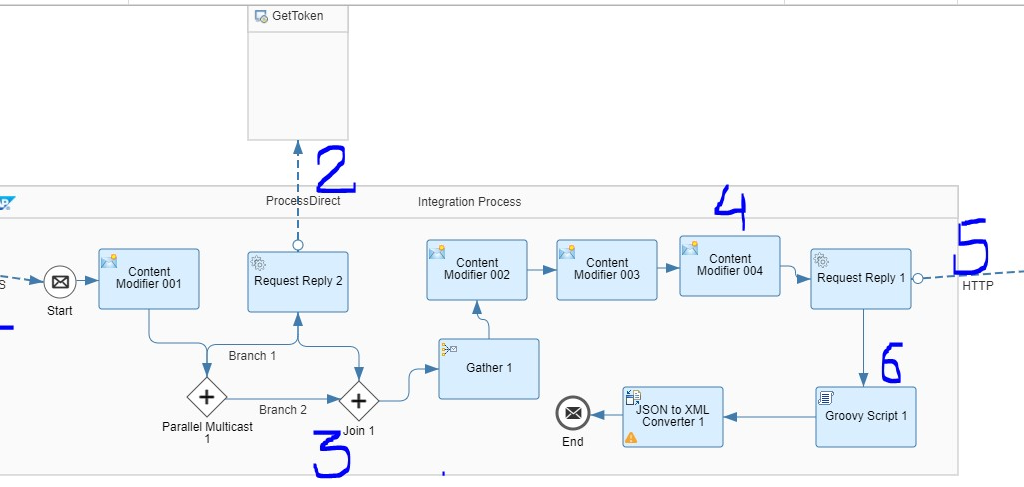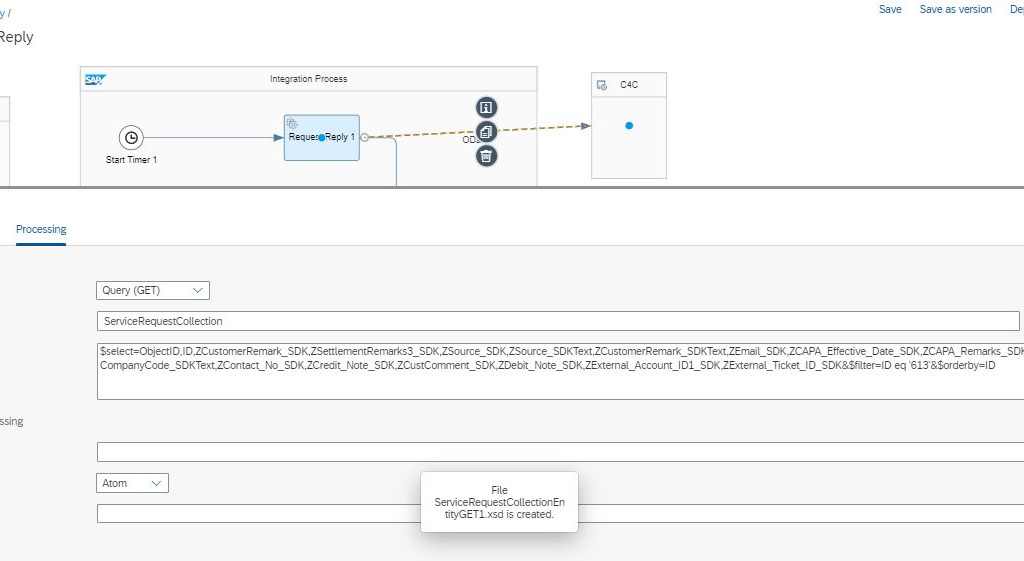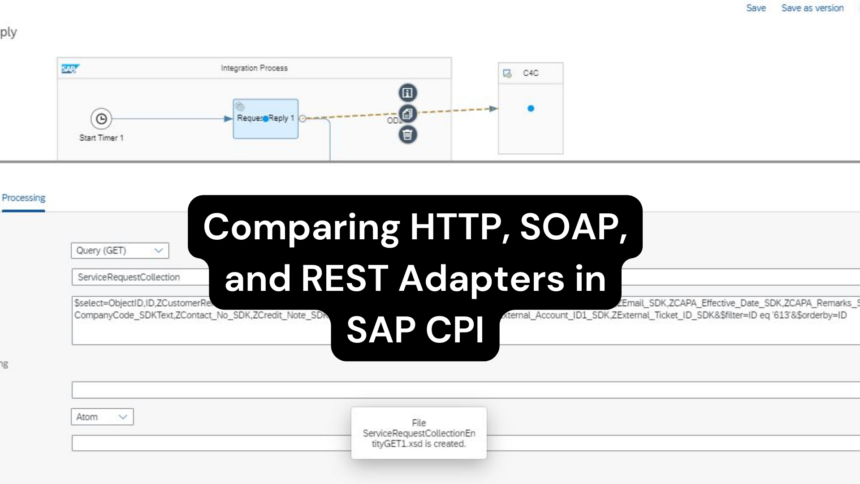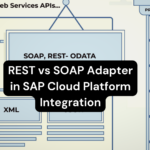When designing integration scenarios in SAP Cloud Platform Integration (CPI), selecting the appropriate adapter is crucial for achieving optimal performance. The HTTP, SOAP, and REST adapters each have unique characteristics that can impact the performance of your integration flows. This blog post provides a detailed comparison of these adapters, focusing on their performance aspects.

HTTP Adapter for CPI Integration
The HTTP adapter in SAP CPI is a versatile tool that facilitates communication with target systems using the HTTP protocol. It is widely used for its simplicity and flexibility.
Performance Characteristics
- Lightweight and Efficient: The HTTP adapter is generally lightweight, as it operates directly over the HTTP protocol without additional overhead. This can lead to faster message processing and lower latency.
- Minimal Overhead: Unlike SOAP, the HTTP adapter does not require complex message structures or additional parsing, which reduces processing time and resource consumption.
- Scalability: The stateless nature of HTTP allows for better scalability. The adapter can handle a high volume of requests without maintaining session state, making it suitable for high-throughput scenarios.
- Session Reuse: The HTTP adapter supports session reuse, which can further enhance performance by minimizing the overhead of repeated authentication and session creation.
- Configuration Flexibility: The HTTP adapter allows for dynamic configuration of HTTP methods, headers, and authentication mechanisms, providing flexibility in optimizing performance for specific use cases.

HTTP Adapter Performance Characteristics
| Performance Aspect | Description |
|---|---|
| Lightweight and Efficient | Operates directly over the HTTP protocol, leading to faster message processing and lower latency. |
| Minimal Overhead | No need for complex message structures, reducing processing time and resource consumption. |
| Scalability | Stateless nature allows handling high volumes of requests efficiently. |
| Session Reuse | Supports session reuse, minimizing overhead from repeated authentication. |
| Configuration Flexibility | Allows dynamic configuration of HTTP methods, headers, and authentication mechanisms. |

SOAP Adapter for CPI Integration
The SOAP adapter in SAP CPI is designed for exchanging structured data using the Simple Object Access Protocol (SOAP). It is commonly used in enterprise environments where robust features and standards compliance are required.
Performance Characteristics
- Complex Message Processing: SOAP messages are XML-based and often include additional elements such as headers, envelopes, and security tokens. This complexity can lead to higher processing times and increased resource consumption.
- Built-in Security and Reliability: The SOAP adapter supports WS-Security and WS-ReliableMessaging standards, which provide robust security and reliability features. However, these features add to the processing overhead and can impact performance.
- Session Management: SOAP can support both stateless and stateful operations. Stateful operations, while beneficial for certain business processes, can limit scalability and increase resource usage.
- XML Parsing Overhead: The need to parse and generate XML messages adds to the processing time. This can be a significant factor in scenarios with large or complex data structures.
- Tooling and Standards Compliance: SOAP’s reliance on WSDL for service description and its adherence to strict standards can simplify integration with legacy systems but may also introduce performance bottlenecks due to the additional processing required.
SOAP Adapter Performance Characteristics
| Performance Aspect | Description |
|---|---|
| Complex Message Processing | XML-based messages with headers, envelopes, and security tokens, leading to higher processing times. |
| Built-in Security and Reliability | Supports WS-Security and WS-ReliableMessaging standards, adding processing overhead. |
| Session Management | Can support both stateless and stateful operations, affecting scalability and resource usage. |
| XML Parsing Overhead | Requires parsing and generating XML messages, impacting processing time. |
| Tooling and Standards Compliance | Uses WSDL for service description, simplifying integration with legacy systems but adding processing overhead. |

REST Adapter for CPI Integration
The REST adapter in SAP CPI leverages the REST architectural style, which is widely used for its simplicity, scalability, and performance benefits.
Performance Characteristics
- Lightweight and Fast: RESTful services typically use JSON for data exchange, which is more lightweight and faster to parse than XML. This leads to quicker message processing and lower latency.
- Stateless Communication: Like the HTTP adapter, REST is stateless, which enhances scalability by allowing the server to handle a high volume of requests without maintaining session state.
- Flexible Data Formats: REST supports multiple data formats (JSON, XML, plain text), providing flexibility in optimizing performance based on the specific requirements of the integration scenario.
- Reduced Overhead: REST services generally have minimal overhead compared to SOAP, as they do not require complex message structures or additional processing for security and reliability features.
- Chattiness: One potential drawback of REST is that it can be more “chatty” than SOAP, requiring multiple HTTP requests to achieve the same result that a single SOAP call might accomplish. This can impact performance in scenarios with large data exchanges or complex operations.
REST Adapter Performance Characteristics
| Performance Aspect | Description |
|---|---|
| Lightweight and Fast | Typically uses JSON for data exchange, which is faster to parse than XML. |
| Stateless Communication | Enhances scalability by handling high volumes of requests without maintaining session state. |
| Flexible Data Formats | Supports multiple data formats (JSON, XML, plain text) for performance optimization. |
| Reduced Overhead | Minimal overhead compared to SOAP, with simpler message structures. |
| Chattiness | May require multiple HTTP requests for complex operations, impacting performance. |
Performance Tradeoffs
When comparing the performance of HTTP, SOAP, and REST adapters in SAP CPI, several key tradeoffs emerge:
- Message Complexity:
- HTTP and REST: Both adapters are lightweight and efficient, with minimal overhead. REST’s use of JSON further enhances performance.
- SOAP: The complexity of XML messages and additional processing for security and reliability features can impact performance.
- Scalability:
- HTTP and REST: Both are stateless, allowing for better scalability and handling of high-throughput scenarios.
- SOAP: Stateful operations and XML parsing can limit scalability and increase resource usage.
- Security and Reliability:
- SOAP: Offers robust built-in security and reliability features, which are essential for certain enterprise scenarios but add to the processing overhead.
- HTTP and REST: Security and reliability need to be implemented at the application level, providing flexibility but requiring additional development effort.
- Tooling and Standards:
- SOAP: Adherence to strict standards and use of WSDL can simplify integration with legacy systems but may introduce performance bottlenecks.
- HTTP and REST: More flexible and easier to implement, especially for modern web and mobile applications.
Performance Tradeoffs
| Performance Factor | HTTP Adapter | SOAP Adapter | REST Adapter |
|---|---|---|---|
| Message Complexity | Lightweight and minimal overhead | Complex XML messages, higher overhead | Lightweight JSON messages, minimal overhead |
| Scalability | Stateless, handles high throughput | Stateful operations limit scalability | Stateless, handles high throughput |
| Security and Reliability | Implemented at application level | Built-in robust features, higher overhead | Implemented at application level |
| Tooling and Standards | Flexible and easy to implement | Adheres to strict standards (WSDL) | Flexible and easy to implement |
Conclusion
Choosing the right adapter for your SAP CPI integration scenarios depends on a careful evaluation of your specific performance requirements and use cases.
The HTTP adapter offers simplicity and efficiency, making it ideal for lightweight, high-throughput integrations.
The REST adapter provides similar benefits with added flexibility in data formats and is well-suited for modern, cloud-native applications. The SOAP adapter, while more complex, offers robust security and reliability features, making it essential for certain enterprise scenarios and integrations with legacy systems.
By understanding the performance characteristics and tradeoffs of each adapter, you can make informed decisions that optimize the performance of your integration flows in SAP CPI.
Choosing the right adapter for your SAP CPI integration scenarios requires careful evaluation of specific performance requirements and use cases. Here’s a summary of each adapter’s strengths:
| Adapter Type | Best Suited For |
|---|---|
| HTTP Adapter | Lightweight, high-throughput integrations requiring simplicity and efficiency. |
| REST Adapter | Modern, cloud-native applications needing flexibility in data formats and minimal overhead. |
| SOAP Adapter | Enterprise scenarios requiring robust security and reliability features despite higher processing overhead. |
Also Read: When to Use SOAP Adapters in SAP CPI: A Developer’s Guide – Tech News Before It’s News | Shift GearX
If you liked this article, please share it and subscribe to my website. For consulting work, please visit my website, Shift Gear and I would be glad to help you in your requirement.
Also Read: SAP CPI: A Guide to Setting Up Outbound SOAP Web Services – Tech News Before It’s News | Shift GearX









